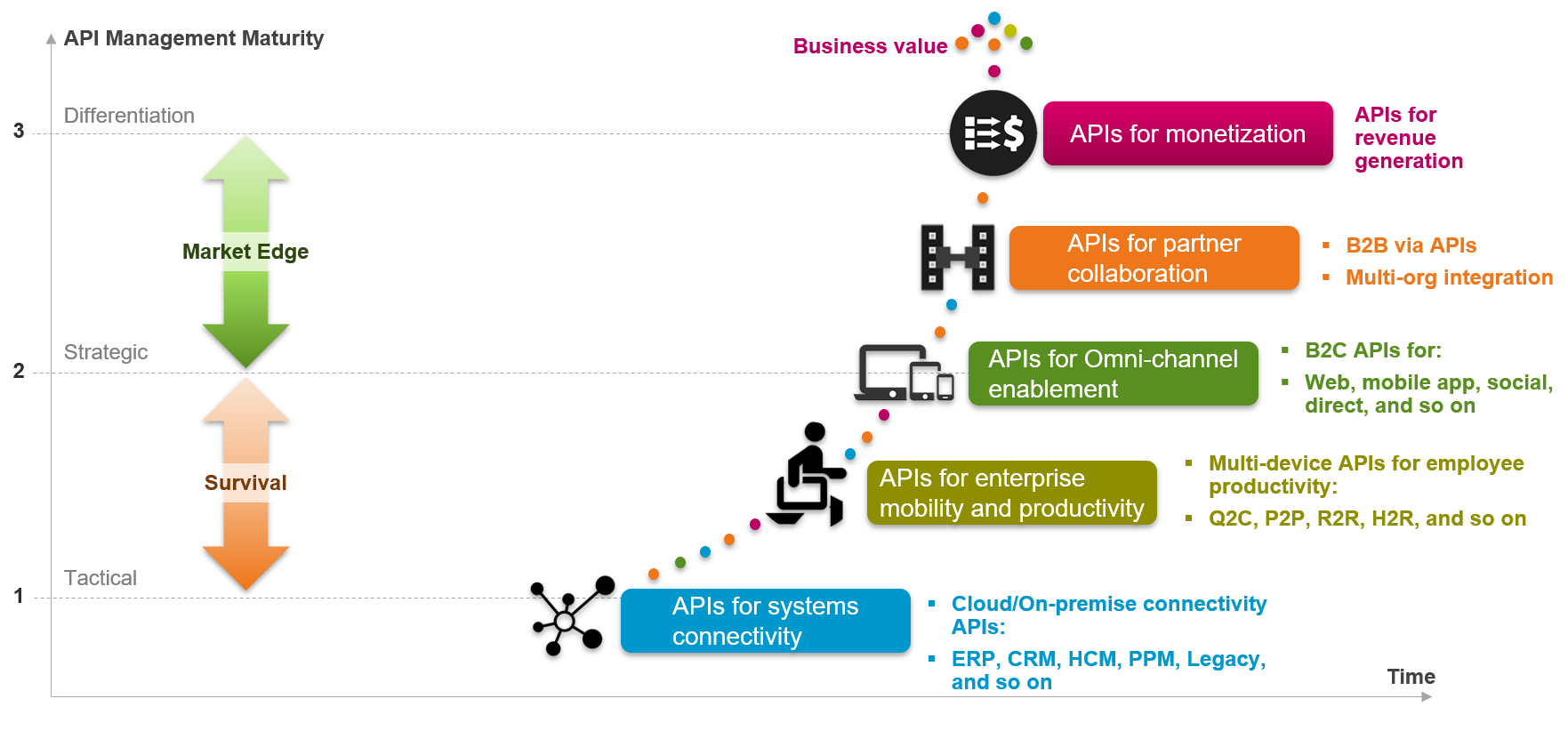Realizing the benefits that APIs have to offer to a business can't be completed in a day, and organizations that think that monetizing their information assets will be a simple and straightforward exercise are going to be in for a surprise. Rome wasn't built in a day, or so it goes.
Like most things, there is always a journey and a path that, when followed, will guide us toward getting to an end goal or a target. It will not necessarily be quick, as that pretty much depends on the pace an organization can deliver, but at least there will be the certainty of avoiding common pitfalls. That is not to say that some organizations might not opt for a different (and perhaps shorter) path.
That said, the following API value chain illustrates both a path and a maturity model to help organizations of all sizes to embark on the journey of API management maturity:

The value chain classifies APIs into five main groups. Each group is determined based on the business value it adds, which, in turn, also dictates maturity according to this business-led model:
|
API group |
Description |
API maturity |
Business value |
|
APIs for system connectivity |
The most basic group of APIs, as their aim is to provide access to core enterprise information assets, such as systems of record. Could be an on-premise system or SaaS applications. |
Level 1 – tactical |
Access to core information assets is the main business value. The benefit that can be realized from such access pretty much depends on the solutions built on top. |
|
APIs for enterprise mobility |
APIs created in support of mobility solutions, meaning that they are not just about access to information, but rather they provide access to business processes and other business capabilities. |
Level 1 – tactical |
This group of APIs has a more direct and measurable impact on the business, which can result in optimization of business processes and effectiveness gained by allowing employees to interact with systems in different ways and digital channels. |
|
APIs for enterprise mobility and productivity |
APIs that enable a business to offer goods and services to customers via multiple digital channels. In other words, B2C. APIs in support of Internet of Things (IoT) solutions also fall within this group. |
Level 2 – strategic |
This group of APIs is fundamental for any B2C digital initiative as it enables omnichannel strategies by making information and functionality accessible through multiple channels, for example, web, mobile apps, bots, kiosks, and social media, to name a few. Now, because of this, their business value is evident and easier to quantify or measure. APIs that enable the IoT also fall within this group. These APIs provide IoT devices with access to enterprise information assets and functionality, though it is worth nothing that IoT is a much broader topic and these APIs only represent one element of it. |
|
APIs for partner collaboration |
APIs that enable partner collaboration and Business to Business (B2B) by optimizing and simplifying business transactions. In other words, an API (and much cheaper) alternative to traditional EDI-style integrations. |
Level 2 – strategic |
B2B transactions is a complex topic for many reasons, with integrations and the infrastructures required to do so being a major one. APIs for B2B and partner collaboration can hugely simplify the cost of integration but will also open the door for new ways to engage businesses of all sizes. The business value is considerable, especially for organizations that don't deal with direct sales, but rather indirect ones, and therefore rely on third parties to sell their products and/or services. |
|
APIs for monetization |
APIs offered as commercial products in their own right. As such, their usage also entails a form of fee. The fee does not necessarily have to be a monetary one. As Mark O'Neill, a key integration and API consultant from Gartner, said: "API monetization doesn't just mean charging for API calls."
|
Level 3 – differentiation |
By APIs becoming a saleable product, they also become a new source of direct revenue for the business, where the actual product offered in the form of an API is access to either information and/or business functionality. Therefore, the business value delivered by these products will be directly proportional to the success of the product itself, which also means that other business functions, such as marketing, sales, and finance, should play a role in making a success of the product.
|
|
|
According to Mark, organizations seeking to monetize APIs should first identify their monetization strategy and, from that, derive a charging or pricing model. Further details on how to monetize APIs are provided in Chapter 3, Business-Led API Strategy. |
|
For this reason, although this group of APIs has the highest potential business value, realizing its full potential also requires more maturity, discipline, and alignment with the rest of the business. It must be a business-driven initiative. |
Businesses that want to realize the full business benefits that APIs have to offer, for example, as part of their digital transformation initiatives, should first consider what would be their entry point and, based on that, determine a roadmap to get to the next levels. Details on how to define such a roadmap are described in Chapter 3, Business-Led API Strategy.













































































